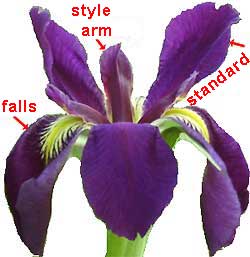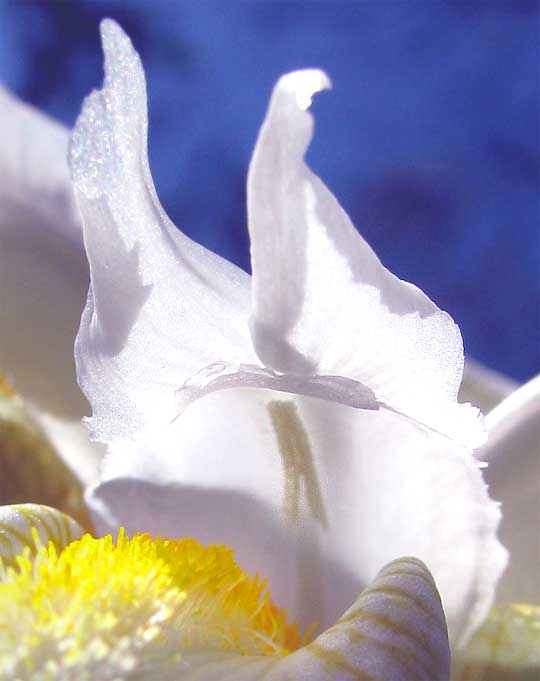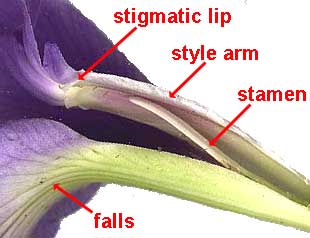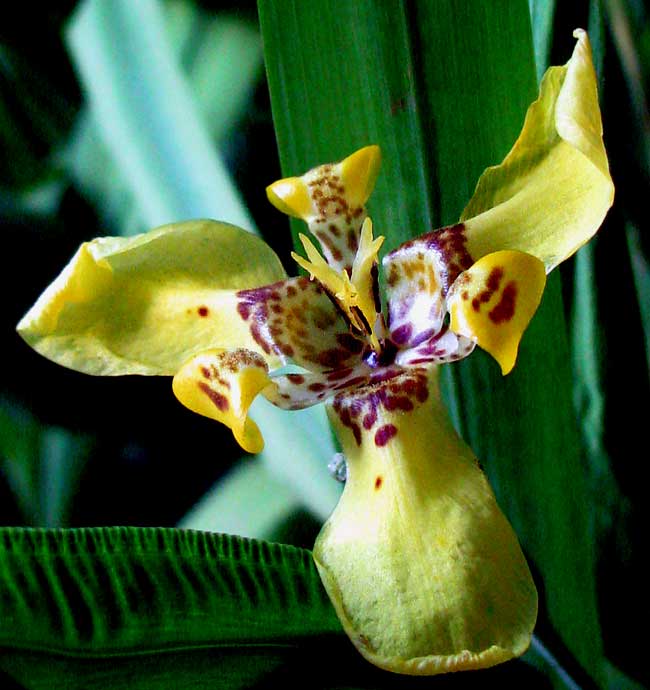
Iris blossoms are highly specialized and different from our Standard Blossom in several interesting ways. The image at the right shows a typical iris flower with some of its unusual modifications and special terminology.
In our Standard Blossom and "average flowers," the corolla is the showy part and the calyx is a greenish, cup-like item below the corolla. In iris flowers, the usual colorful corolla petals are represented by three standards rising above the other parts, attracting pollinators. The iris flower's lowest parts, where you'd expect an inconspicuous, probably green calyx to reside, instead are represented by parts known as falls.

The falls serves as a "landing pad" for pollinators. Notice how the falls in the above flower bear bright lines leading into the blossom's mouth. These serve as nectar guides, directing pollinators toward nectar. At the left, the falls has yellow hairs, known as the beard. Pollinators can be seen holding onto the beard as they scramble into the flower looking for nectar. However, not all iris cultivars have beards on their falls; there are "bearded" and "unbearded" kinds. In the pictureat the left, notice how the beard descends beneath a single stamen, which is attached to a ceiling-like structure known as the style arm.

At the right a style arm from a different kind of iris is of a different color and shape, but with the same structure. The style arms are possibly the most surprising part of the blossom.
In the Standard Blossom, the style is the neck-like part of the female pistil that connects the ovary with the pollen-receiving stigma. Therefore, though a style arm looks like it's part of the corolla, it's actually part of the blossom's female sex organ.

One proof of that, as shown at the left, is that at top of the style arm there's a stigmatic lip, serving as the stigma. When a pollinator enters the iris flower, it squeezes beneath the stigmatic lip, possibly with the stigmatic lip scraping some pollen from the pollinator's body. Pollen grains germinating on the stigmatic lip send their male sex germs the entire length of the style arm, all the way into ovules in the ovary at the bottom of the flower, where the female sex germs reside.

So far we've just been considering kinds of iris flowers grown ornamentally. Such species belong to the genus Iris, of which about 280 wild species are known, 34 species listed for North America. However, the genus Iris is just one genus of about 65 genera assigned to the Iris Family, the Iridaceae. It's always interesting to encounter plants belonging to the Iris Family, but not the genus Iris. For instance, at the right you see the Walking Iris, or Toad-Cup, Neomarica longifolia.
Walking Irises display some genus Iris features, but they lacks the falls. You can make out the beginning of the style arm, however. Also, the plants are called Walking Irises because little Walking Iris plantlets form in the inflorescence, then when the inflorescence bends to the ground at the flowering season's end, the plantlets root, form new plants, and this enables the population year after year to "walk" into new territory. No Iris could ever do that
IDENTIFICATION KEYS IN FLORA OF NORTH AMERICA
You can "key out" your unknown finds of native plants belonging to the Iris Family at the Flora of North America website. Go to the key near the center of the page you arrive at when you click the above link, figure out your unknown plant's genus, click on the genus, then key out the species. These are technical keys using technical terms, but they are very useful.